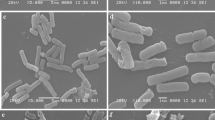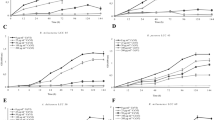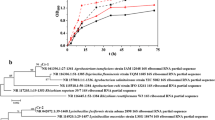Abstract
Reclamation of chromium-contaminated soil by bacteria is a big confront concerning to soil health restoration, food safety, and environmental protection. Herein, the chromium-resistant Bacillus aryabhattai CTSI-07 (MG757377) showed resistance to 1000 and 300 ppm of Cr(VI) in nutrient rich Luria Bertani (LB) and nutrient-deficient sucrose low phosphate (SLP) medium, respectively. It reduced 96.7% of Cr(VI) from contaminated soil in the presence of 100 ppm of Mg within 96 h under optimized conditions. Furthermore, Cr(VI) reduction by the bacteria was validated by Fourier transform infrared spectroscopic (FTIR) and X-ray diffraction (XRD) analysis. Besides Cr(VI) reduction, the bacterial strain also showed plant growth promoting traits like N2 fixation and indole acetic acid (IAA) production. On the other hand, transmission electron microscopy (TEM) imaging confirmed polyhydroxyalkanoates’ (PHAs) granule accumulation and 0.5 g/l of PHAs was extracted from bacterial cell using SLP medium. Infra-red (IR) spectra and proton nuclear magnetic resonance (1H NMR) chemical shift patterns established the PHAs as polyhydroxybutyrate (PHB). Melting (Tm) and thermal degradation (Td) temperature of the PHB were 169 °C and 275 °C, respectively, as evident from thermogravimetry differential thermal analysis (TG-DTA). Atomic force microscopic (AFM) imaging depicted that the PHB film surface was rough and regular. Furthermore, the multi-metal-resistant, plant growth–promoting, and PHB-producing bacteria could reduce 99.82% of Cr(VI) from contaminated soil within 120 days in pot culture. Thus, it can be used for long-term reclamation of chromium-contaminated soil to restore soil health, provide food safety, and environmental protection.






Similar content being viewed by others
Data Availability
Not applicable.
References
Aslam F, Yasmin A, Sohail S (2019) Bioaccumulation of lead, chromium, and nickel by bacteria from three different genera isolated from industrial effluent. Int Microbiol 23:253–261. https://doi.org/10.1007/s10123-019-00098-w
Baikar V, Rane A, Deopurkar R (2017) Characterization of polyhydroxyalkanoate produced by Bacillus megaterium VB89 isolated from Nisargruna biogas plant. Appl Biochem Biotechnol 183(1):241–253. https://doi.org/10.1007/s12010-017-2441-4
Bao Z, Wang X, Wang Q, Zou L, Peng L, Li W, Tu W, Li Q (2023) A novel method of domestication combined with ARTP to improve the reduction ability of Bacillus velezensis to Cr(VI). J Environ Chem Eng 11. https://doi.org/10.1016/j.jece.2022.109091
Batool R, Tabassum T, Ali M (2017) Evaluation of Cr(VI) remediation potential of Eichornia sp. in conjunction with chromium-resistant bacterial strains. Trop J Pharm Res 16(5):1005–1011. https://doi.org/10.4314/tjpr.v16i5.6
Bhubalan K, Rathi DN, Abe H, Iwata T, Sudesh K (2010) Improved synthesis of P(3HB-co-3HV-co-3HHx) terpolymers by mutant Cupriavidus necator using the PHA synthase gene of Chromobacterium sp. USM2 with high affinity towards 3HV. Polym Degrad Stab 95:1436–1442. https://doi.org/10.1016/j.polymdegradstab.2009.12.018
Biradar GG, Shivasharana CT, Kaliwal BB (2017) Characterization of polyhydroxybutyrate (PHB) produced by novel bacterium Lysinibacillus sphaericus BBKGBS6 isolated from soil. J Polym Environ 26(4):1685–1701. https://doi.org/10.1007/s10924-017-1054-x
Biswas J, Bose P, Mandal S, Paul AK (2018) Reduction of hexavalent chromium by a moderately halophilic bacterium Halomonas smyrnensis KS802 under saline environment. Environ Sustain. https://doi.org/10.1007/s42398-018-00037-x
Chen J, Tian Y (2021) Hexavalent chromium reducing bacteria: mechanism of reduction and characteristics. Environ Sci Pollut Res 28:20981–20997. https://doi.org/10.1007/s11356-021-13325-7
Das S, Mishra J, Das SK, Pandey S, Rao DS, Chakraborty A, Sudarshan M, Das N, Thatoi H (2014) Investigation on mechanism of Cr(VI) reduction and removal by Bacillus amyloliquefaciens, a novel chromate tolerant bacterium isolated from chromite mine soil. Chemosphere 96:112–121. https://doi.org/10.1016/j.chemosphere.2013.08.080
Dash A, Mohanty S, Samantaray DP (2020) Study on biodegradability of PHB produced through different fermentation processes using dextrose as a substrate. Res J Biotechnol 15(4):26–31
Desouky SE, El-Shiekh HH, Elabd MA, Shehab AM (2014) Screening, optimization and extraction of polyhydroxyalkanoates (PHAs) from Bacillus thuringienesis. J Adv Biol Biotechonol 1(1):40–54
Devadarshini D, Mohapatra S, Pati S, Maity S, Rath CC, Jena PK, Samantaray DP (2022) Evaluation of PHAs production by mixed bacterial culture under submerged fermentation. Biologia 78:895–902. https://doi.org/10.1007/s11756-022-01302-5
Elahi A, Rehman A, Hussain SZ, Zulfiqar S, Shakoori AR (2022) Isolation and characterization of a highly effective bacterium Bacillus cereus b-535k for hexavalent chromium detoxification. Saudi J Biol Sci 29(4):2878–2885. https://doi.org/10.1016/j.sjbs.2022.01.027
Gong Y, Werth CJ, He Y, Su Y, Zhang Y, Zhou X (2018) Intracellular versus extracellular accumulation of hexavalent chromium reduction products by Geobacter sulfurreducens PCA. Environ Pollut 240:485–492. https://doi.org/10.1016/j.envpol.2018.04.046
Hansda A, Kumar V, Anshumali A, Usmani Z (2014) Phytoremediation of heavy metals contaminated soil using plant growth promoting rhizobacteria (PGPR): a current perspective. Recent Res Sci Technol 6:131–134
Hussain AAA, Al-Saadi AGM (2021) Isolation and identification of some chromium resistant bacteria from some contaminated sites. J Phys Conf Ser 1999. https://doi.org/10.1088/1742-6596/1999/1/012022
ICAR-Indian Institute of Water Mangement India (2019) Annual report 2018-2019. http://www.iiwm.res.in/pdf/IIWM_AR_2018-19.pdf
Kalsoom BA, Din G, Din SU, Jamil J, Hasan F, Khan S, Badshah M, Shah AA (2021) Isolation and screening of chromium-resistant bacteria from industrial waste for bioremediation purposes. Braz J Biol 83. https://doi.org/10.1590/1519-6984.242536
Kamala-Kannan S, Lee KJ (2008) Metal tolerance and antibiotic resistance of Bacillus species isolated from sunchon bay sediments, South Korea. Biotechnol 7(1):149–152. https://doi.org/10.3923/biotech.2008.149.152
Kaparwan A (2023) Hexavalent chromium induced toxicity in nature and living beings. Int Educ Sci Res J 9:3–9
Karthik C, Ramkumar S, Pugazhendhi A, Gopalakrishnan K, Arulselvi I (2017) Biosorption and biotransformation of Cr(VI) by novel Cellulosimicrobium funkei strain AR6. J Taiwan Inst Chem E 70:282–290. https://doi.org/10.1016/j.jtice.2016.11.006
Li MH, Gao XY, Li C, Yang CY, Fu CA, Liu J, Wang R, Chen LX, Lin JG, Liu XM, Lin JQ, Pang X (2020a) Isolation and identification of chromium reducing Bacillus cereus species from chromium-contaminated soil for the biological detoxification of chromium. Int J Environ Res Public Health 17(6):1–13. https://doi.org/10.3390/ijerph17062118
Li Y, Wang H, Wu P, Yu L, Rehman S, Wang J, Yang S, Zhu N (2020b) Bioreduction of hexavalent chromium on goethite in the presence of Pseudomonas aeruginosa. Environ Pollut 265:1–8. https://doi.org/10.1016/j.envpol.2020.114765
Maity S, Das S, Mohapatra S, Tripathy AD, Akthar J, Pati S, Samantaray DP (2020) Growth associated PHB production by the novel Zobellellae tiwanensis strain DD5 from banana peels under submerged fermentation. Int J Biol Macromol 153:461–469. https://doi.org/10.1016/j.ijbiomac.2020.03.004
Mangaiyarkarasia M, Vincenta S, Janarthanan B, Subba R, Tata BV (2011) Bio-reduction of Cr(VI) by alkaliphilic Bacillus subtilis and interaction of the membrane groups. Saudi J Biol Sci 18:157–167. https://doi.org/10.1016/j.sjbs.2010.12.003
Marzan LW, Hossain M, Mina SA, Akter Y, Chowdhury AMMZ (2017) Isolation and biochemical characterization of heavy-metal resistant bacteria from tannery effluent in Chittagong city, Bangladesh: bioremediation viewpoint. Egypt J Aquat Res. https://doi.org/10.1016/j.ejar.2016.11.002
Mishra RR, Dhal B, Dutta SK, Dangar TK, Das NN, Thatoi HN (2012) Optimization and characterization of chromium(VI) reduction in saline condition by moderately halophilic Vigri-bacillus sp. isolated from mangrove soil of Bhitarkanika, India. J Hazard Mater 227–228:219–226. https://doi.org/10.1016/j.jhazmat.2012.05.063
Mohapatra S, Pattnaik S, Maity S, Mohapatra S, Sharma S, Akhtar J, Pati S, Samantaray DP, Varma A (2020) Comparative analysis of PHAs production by Bacillus megaterium OUAT 016 under submerged and solid-state fermentation. Saudi J Biol Sci 27:1242–1250. https://doi.org/10.1016/j.sjbs.2020.02.001
Mohapatra S, Samantaray DP, Samantaray SM, Mishra BB, Das S, Majumdar S, Pradhan SK, Rath SN, Rath CC, Akthar J, Achary KG (2016) Structural and thermal characterization of PHAs produced by Lysinibacillus sp. through submerged fermentation process. Int J Biol Macromol 93:1161–1167. https://doi.org/10.1016/j.ijbiomac.2016.09.077
Mohapatra S, Sarkar B, Samantaray DP, Daware A, Maity S, Pattnaik S, Bhattacharjee S (2017) Bioconversion of fish solid waste into PHB using Bacillus subtilis based submerged fermentation process. Environ Technol 1-8. https://doi.org/10.1080/09593330.2017.1291759
Musa H, Bolanle BB, Kasim FH, Arbain D (2016) Screening and production of polyhydroxybutyrate (PHB) by bacterial strains isolated from rhizosphere soil of groundnut plants. Sains Malaysiana 45(10):1469–1476
Pati S, Maity S, Dash A, Jema S, Mohapatra S, Das S, Samantaray DP (2020) Biocompatible PHB production from Bacillus species under submerged and solid-state fermentation through different downstream processing. Curr Microbiol 77:1203–1209. https://doi.org/10.1007/s00284-020-01922-7
Pattnaik S, Dash D, Mohapatra S, Pattnaik M, Marandi AK, Das S, Samantaray DP (2019) Improvement of rice plant productivity by native Cr(VI) reducing and plant growth promoting soil bacteria Enterobacter cloacae. Chemosphere 240:1–9. https://doi.org/10.1016/j.chemosphere.2019.124895
Pattnaik S, Dash D, Samantaray DP (2017) Exploration of NPK activity showing chromium resistant bacteria from Sukinda mining area. Int J Curr Microbiol App Sci 6:535–542. https://doi.org/10.20546/ijcmas.2017.612.605
Pattnaik S, Dash D, Samantaray DP (2018) Evaluation of IAA and PHAs production by chromium resistant bacterial isolates. J Exp Biol Agric Sci 6(3):466–471. https://doi.org/10.18006/2018.6(3).466.471
Pattnaik S, Mohapatra S, Pati S, Dash D, Devadarshini D, Tanaya K, Mishra BB, Samantaray DP (2021) Microbial bioremediation of Cr(VI)-contaminated soil for sustainable agriculture. In: Dash HR, Das S (eds) Microbial biodegradation and bioremediation: techniques and case studies for environmental pollution, 2nd edn. Elsevier, pp 395–407. https://doi.org/10.1016/B978-0-323-85455-9.00008-4
Paul A, Dey S, Ram DK, Das AP (2023) Hexavalent chromium pollution and its sustainable management through bioremediation. Geomicrobiol J. https://doi.org/10.1080/01490451.2023.2218377
Princy S, Prabagaran SR (2020) Reduction of Cr(VI) by Bacillus species isolated from tannery effluent contaminated sites of Tamil Nadu, India. Mater Today. https://doi.org/10.1016/j.matpr.2020.04.850
Raman NM, Asokan S, Shobana Sundari N, Ramasamy S (2017) Bioremediation of chromium(VI) by Stenotrophomonas maltophilia isolated from tannery effluent. Int J Environ Sci Technol 15:207–216. https://doi.org/10.1007/s13762-017-1378-z
Ramirez V, Baez A, Lopez P, Bustillos R, Villalobos MA, Carreno R, Contreras JL, Rojas JM, Fuentes LE, Martinez J, Munive JA (2019) Chromium hyper-tolerant Bacillus sp. MH778713 assists phytoremediation of heavy metals by Mesquite trees (Prosopis laevigata). Front Microbiol 10. https://doi.org/10.3389/fmicb.2019.01833
Rathi DN, Amir HG, Abed RMM, Kosugi A, Arai T, Sulaiman O, Hashim R, Sudesh K (2013) Polyhydroxyalkanoate biosynthesis and simplified polymer recovery by a novel moderately halophilic bacterium isolated from hypersaline microbial mats. J Appl Microbiol 114:384–395. https://doi.org/10.1111/jam.12083
Rodrıguez-Contreras A, Koller M, Dias MMS, Calafell-Monfort M, Braunegg G, Marques-Calvo MS (2013) High production of poly (3-hydroxybutyrate) from a wild Bacillus megaterium bolivian strain. J Appl Microbiol 114(5):1378–1387. https://doi.org/10.1111/jam.12151
Saitou N, Nei M (1987) The neighbour-joining method: a new method for reconstructing phylogenetic trees. Mol Biol Evol 4:406–425. https://doi.org/10.1093/oxfordjournals.molbev.a040454
Sambrook J, Russell DW (2001) Commonly used techniques in molecular cloning. Cold Spring Harbor Laboratory Press, New York
Sehgal R, Gupta R (2020) Polyhydroxyalkanoate and its efficient production: an eco-friendly approach towards development. 3 Biotech 10:1–14. https://doi.org/10.1007/s13205-020-02550-5
Seragadam P, Rai A, Ghanta KC, Srinivas B, Lahiri SK, Dutta S (2021) Bioremediation of hexavalent chromium from wastewater using bacteria-a green technology. Biodegradation 32(4):449–466. https://doi.org/10.1007/s10532-021-09947-w
Shah AP, Archana G (2021) Evaluation of bacterial strains isolated from late quaternary alluvial sediments spanning ~ 28 m in depth for heavy metal tolerance and Cr(VI) removal ability. Int Microbiol. https://doi.org/10.1007/s10123-021-00174-0
Soni SK, Singh R, Tiwari S (2022) Management of chromium(VI)-contaminated soils through synergistic application of vermi-compost, chromate reducing rhizobacteria and arbuscular mycorrhizal fungi (AMF) reduced plant toxicity and improved yield attributes in Ocimum basilicum L. Arch Microbiol 204:614. https://doi.org/10.1007/s00203-022-03230-z
Sun Y, Jin J, Li W, Zhang S, Wang F (2021) Hexavalent chromium removal by a resistant strain Bacillus cereus ZY-2009. Environ Technol. https://doi.org/10.1080/09593330.2021.2016994
Tamura K, Stecher G, Peterson D, Filipski A, Kumar S (2013) MEGA6: Molecular evolutionary genetics analysis version 6.0. Mol Biol Evol 30:2725–2729. https://doi.org/10.1093/molbev/mst197
Tasleem M, El-Sayed AAA, Hussein WM, Alrehaily A (2022) Bioremediation of chromium-contaminated groundwater using chromate reductase from Pseudomonas putida: an in silico approach. Water J 15. https://doi.org/10.3390/w15010150
Upadhyay N, Vishwakarma K, Singh J, Mishra M, Kumar V, Rani R, Mishra RK, Chauhan DK, Tripathi DK, Sharma S (2017) Tolerance and reduction of chromium(VI) by Bacillus sp. Mnu16 isolated from contaminated coal mining. Soil Front Plant Sci 8:1–8. https://doi.org/10.3389/fpls.2017.00778
Wadood HZ, Latif A, Mukhtar H, Javed M, Mukhta H, Rehman Y (2021) Planktonic cells of Staphylococcus and Bacillus species capable of faster chromium reduction in short incubation times as compared to their biofilms. Arab J Geosci 14:1–9. https://doi.org/10.1007/s12517-021-08226-5
Wang J, Liu S, Huang J, Qu Z (2021) A review on polyhydroxyalkanoate production from agricultural waste biomass: development, advances, circular approach, and challenges. Bioresour Technol 342. https://doi.org/10.1016/j.biortech.2021.126008
Wang Y, Peng B, Yang Z, Chai L, Liao Q, Zhang Z, Li C (2015) Bacterial community dynamics during bioremediation of Cr(VI)-contaminated soil. Appl Soil Ecol 85:50–55. https://doi.org/10.1016/j.apsoil.2014.09.002
Xu Z, Li D, Tan Y, Yang Q, Xiong H, Li J, Deng H, Lin Z (2021) Investigation on the treatment of Cr(VI) by Bacillus cereus 12-2 under metal cation. Surf Interfaces 24:1–5. https://doi.org/10.1016/j.surfin.2021.101141
Acknowledgements
The authors are grateful to the CIF, OUAT Odisha for laboratory support to carry out the research work.
Author information
Authors and Affiliations
Contributions
Dr. Deviprasad Samantaray and Dr. Debasis Dash designed and supervised the research work. Dr. Swati Pattnaik carried out the research work and manuscript drafting. Dr. Swati Mohapatra and Dr. Sumanta Kumar Mishra reviewed the manuscript. Dr. Swayamsidha Pati and Matrujyoti Pattnaik collected and analyzed data. Dr. Sudipta Maity provided assistance in statistical analysis of data. Deepika Devadarshini and Swati Samal prepared figures.
Corresponding author
Ethics declarations
Ethics approval
Not applicable
Consent to participate
Not applicable
Consent to publish
Not applicable
Competing interests
The authors declare no competing interests.
Additional information
Publisher’s Note
Springer Nature remains neutral with regard to jurisdictional claims in published maps and institutional affiliations.
Supplementary information
ESM 1
(DOC 3.48 MB)
Rights and permissions
Springer Nature or its licensor (e.g. a society or other partner) holds exclusive rights to this article under a publishing agreement with the author(s) or other rightsholder(s); author self-archiving of the accepted manuscript version of this article is solely governed by the terms of such publishing agreement and applicable law.
About this article
Cite this article
Pattnaik, S., Dash, D., Mohapatra, S. et al. Reclamation of chromium-contaminated soil by native Cr(VI)-reducing and PHA-accumulating Bacillus aryabhattai CTSI-07. Int Microbiol (2023). https://doi.org/10.1007/s10123-023-00421-6
Received:
Revised:
Accepted:
Published:
DOI: https://doi.org/10.1007/s10123-023-00421-6




